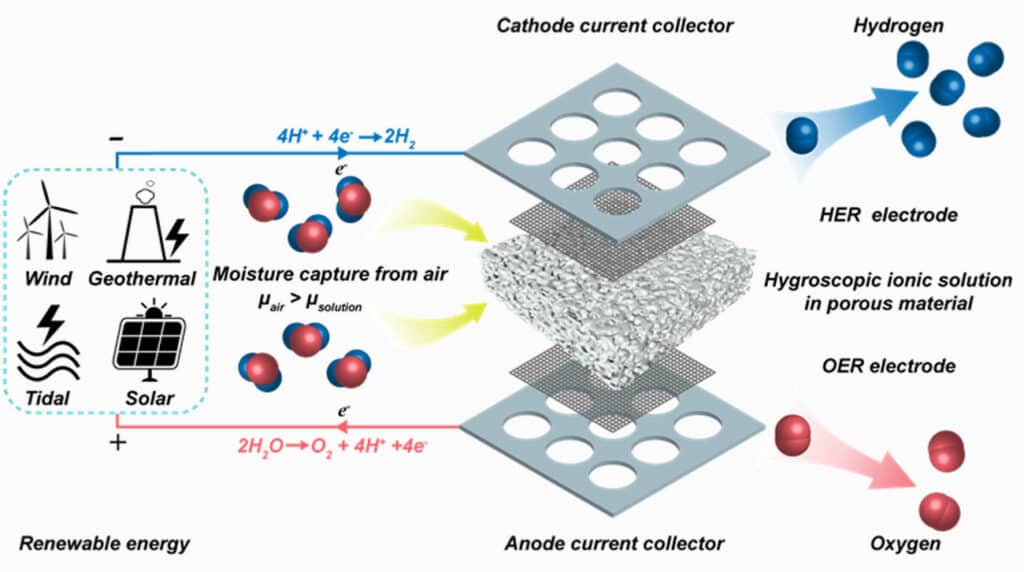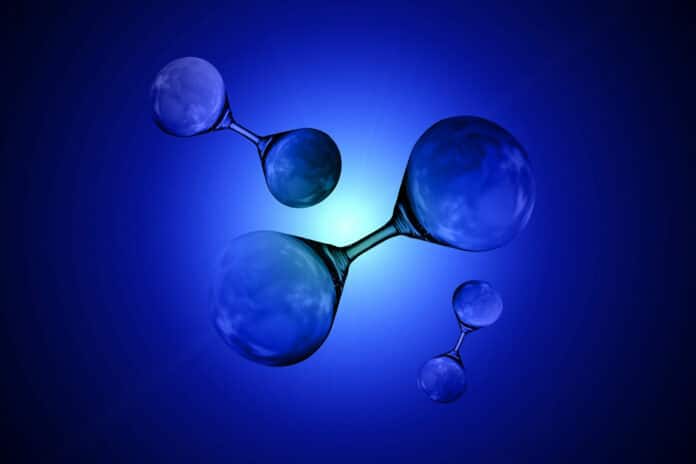Green hydrogen produced by water splitting using renewable energy is the most promising energy carrier of the low-carbon economy. But producing hydrogen through water electrolysis relies on a very clean water supply, which is a scarce commodity.
Researchers at the University of Melbourne have developed a technique and a prototype device to generate hydrogen from the air, decoupling production from freshwater resources and providing a new direction for a carbon-free future. The technology is called Direct Air Electrolyser (DAE) and works by draining water directly from the air before then going through the standard electrolysis process.
The new device, the DAE, is like other electrolyzers; it is made of a panel of metal plates – the electrodes – which supply a current (taken from renewables) for the water splitting process. But the secret is the porous medium between the plates which is soaked with a hygroscopic ionic solution – a chemical that can absorb moisture from air spontaneously.
Electricity from renewable sources like solar or wind can then be used to split the water into hydrogen, which starts being released at the cathode, and oxygen at the anode. The researchers believe that this is the first time pure hydrogen has been pulled directly from the air.
“It’s simple, but this material likes to take water molecules from the air. When they’ve been taken from the air, they become liquid and ready for electrolysis. That’s the core of this invention,” said the lead researcher Dr. Kevin Gang Li, a senior lecturer in Chemical Engineering. “If you expose the device to air, it will produce hydrogen. That’s why we call it Direct Air Electrolyser. You use air as the feed to the device, not liquid water like electrolyzers currently do.”

“We see an area that has no groundwater and thinks it’s unsuitable for hydrogen production. But there is always abundant fresh water in the air,” said Kevin Li. “Even Alice Springs, which is in part of the desert, has around 20% relative humidity. This is more than enough for us to produce hydrogen onsite using renewable energy.”
Their so-called direct air electrolysis module can work under a bone-dry environment with a relative humidity of 4%, overcoming water supply issues and producing sustainable green hydrogen with minimal environmental impact.
During the experiments, the prototype operated for 12 consecutive days with a stable performance outside the group’s lab building in Melbourne, at a Faradaic efficiency of around 95%. On warm sunny days, the prototype hooked up to a paperback-sized solar panel was able to generate 3.7 cubic meters of high-purity hydrogen per day per square meter of the cathode. The group has another device that’s been running for 8 months with the Faradaic efficiency of hydrogen remaining around 90%, without any maintenance.
The technology has a wide range of potential applications, and pure hydrogen can be generated anywhere on earth. The next steps are to do large-scale tests to find out how it performs in harsh conditions, including icing temperatures, rain, and extremely dry climates, and at a much larger size.
“We are in the process of scaling up the DAE – from a five-layer stack to one-meter square, then 10 meters, and so on. And we can simulate a dry climate in the lab, but that’s not a real desert. So, we want to take it to Alice Springs and spend a couple of weeks, see how it goes,” Li says.
Journal reference:
- Guo, J., Zhang, Y., Zavabeti, A. et al. Hydrogen production from the air. Nat Commun 13, 5046 (2022). DOI: 10.1038/s41467-022-32652-y
